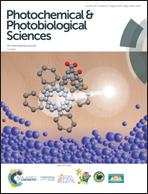Influence of the electron donor properties of hypericin on its sensitizing ability in DSSCs†
Abstract
Rising demands for renewable energy sources have led to the development of dye sensitized solar cells. It is a challenge to find a good and low cost sensitizer, which has a low environmental impact. In this work, we conducted spectroscopic and electrochemical experiments, as well as quantum-chemical calculations of the natural pigment hypericin, in order to provide insight into its sensitizing efficiency. To this end, three identical cells were made and characterized. Although this pigment exhibited good adsorption onto a semiconductor surface, a high molar absorption coefficient (43 700 L mol−1 cm−1) and favorable alignment of energy levels and provided a long lifetime of electrons (17.8 ms) in the TiO2 photoanode, it was found that the efficiency of hypericin-sensitized solar cells was very low, only 0.0245%. We suggest that this inefficiency originated from a low injection of electrons into the conduction band of TiO2. This conclusion is supported by the density functional theory calculations which revealed a low electron density in the anchoring groups of electronically excited hypericin. The results of this work could be valuable not only in the photovoltaic aspect, but also for application of hypericin in medicine in photodynamic therapy.



 Please wait while we load your content...
Please wait while we load your content...